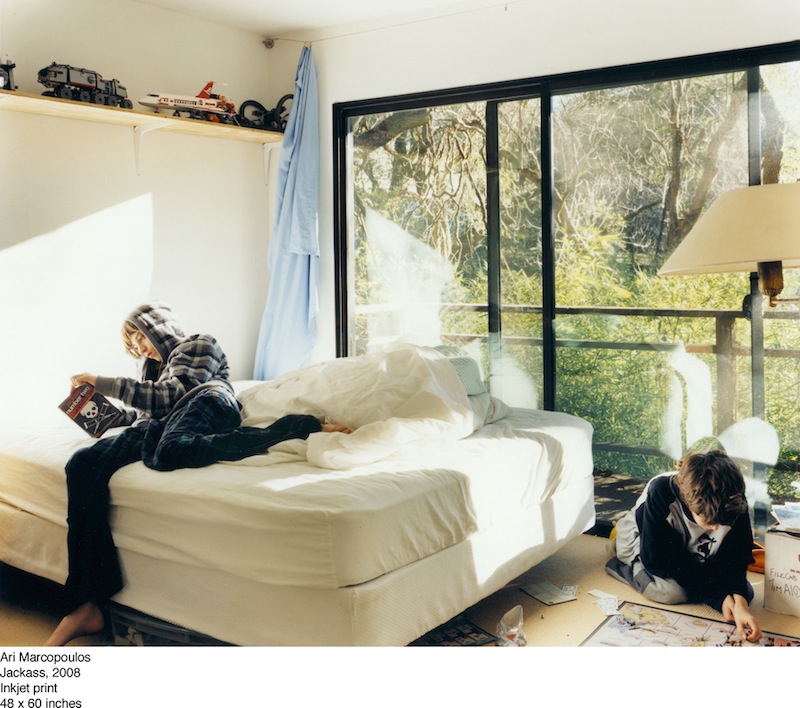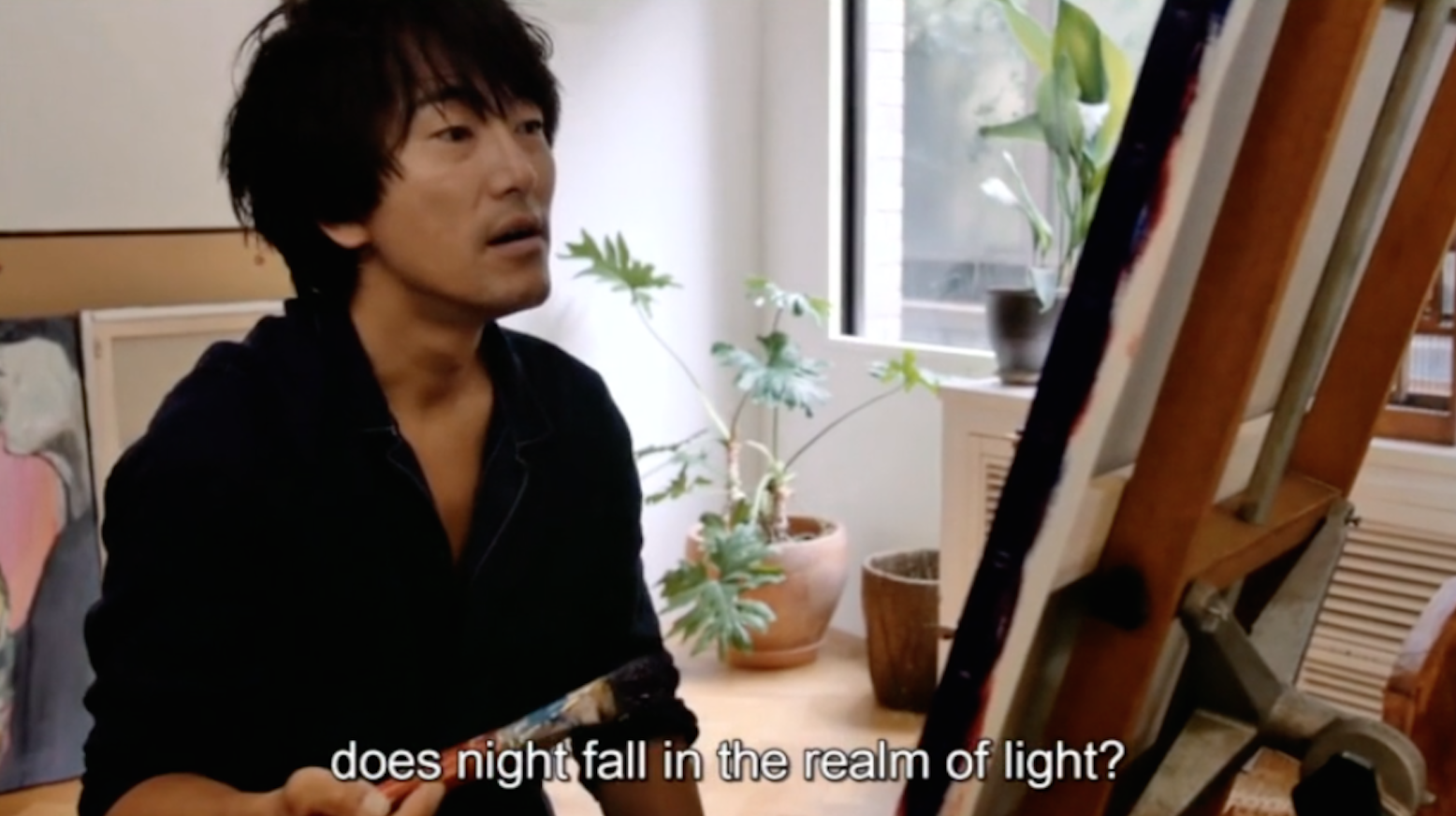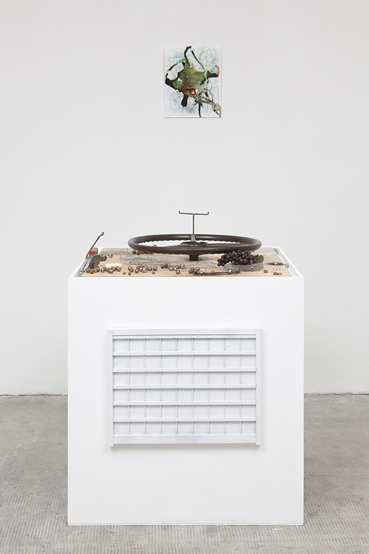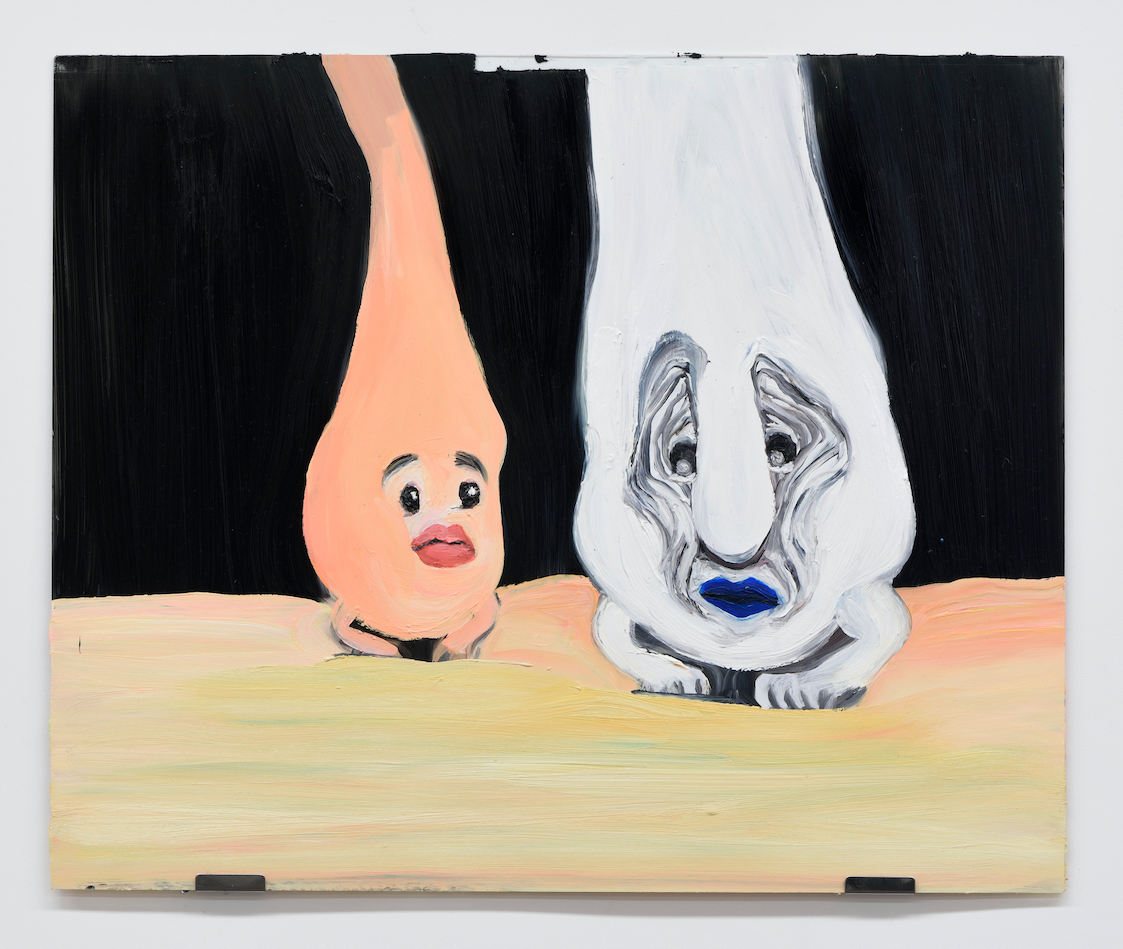
© » KADIST
Ari Marcopoulos
In Jackass (2008) by Ari Marcopoulos, his two sons, Cairo and Ethan, are pictured relaxing in a disheveled bedroom in their Sonoma home. One plays with some sort of board game while the other holds either a book or DVD of the movie Jackass Number Two, presumably the source of the photograph’s title. As Marcopoulos has continued to document his sons, and as they have become teenagers, the images of them begin to closely resemble the teenagers in much of his earlier work.

© » KADIST
Ari Marcopoulos
A photograph of a tin box full of marijuana simply titled Green Box, speaks to the constantly changing status of the substance–once taboo or illicit, now a symbol of a growing industry in Northern California. In the past a photograph of marijuana would more likely be found in an evidence file than an art museum or gallery, but today continued debates about the legality of marijuana and the industry surrounding it has brought the substance into common public view. Green Box is a strong example of the current sociopolitical state of California and the grey areas that exist in legislature and at the same time illustrates the unavoidable commercialization of once underground cultures.

© » KADIST
Khadim Ali & Sher Ali
Drawing & Print (Drawing & Print)
Transaction/Evacuation is a collaborative painting by Khadim Ali and Sher Ali, and is part of a larger collaborative body of works by the artists, which share the same title. Like Khadim Ali, Sher Ali is also part of the Hazara people, and experienced massive personal and social trauma early in life, losing his parents at the age of ten and witnessing the devastation of the Afghan Civil War in his native Kabul. The horned figure in the foreground represents Rustam, a legendary hero in Iranian mythology and central character in the Shahnameh, who depicted here by the artists as a potbellied demon, stripped away of its heroism.

© » KADIST
Aki Kondo
Hikari (Light) (2015) depicts a fantastical and wrenching story about Juneko, a terminally ill young woman who communicates with her lover, a painter, through a portrait of her produced shortly after her death. As Juneko becomes sicker, her hair begins to fall out, a symptom of her unnamed illness. As her condition deteriorates, the film toggles back and forth with the animated story of Mogeji, a white strand of hair inhabiting Juneko’s body who becomes anthropomorphized through Kondo’s animation and recounts his own story of mortality and loss.

© » KADIST
Uri Aran
Like much of Aran’s work this sculptural installation is akin to a riddle. It has no exact meaning, and it can be somewhat frustrating, yet with careful inspection it begins to reveal unexpected information. In his 2014 exhibition at Peep-Hole, Milan, where this work was shown, Aran referred in a series of new works to Mancala games.

© » KADIST
Aria Dean
Although typically sold today as a novelty item for flower arrangements and interior decorating flourishes, cotton can also be seen as a proxy, through synecdoche, for US slavery. Dead Zone (4) by Aria Dean presents a preserved blossom of that trade’s primary cash crop, cotton, crystalized in a state of non-decay whilst encased under protective glass. Hidden in the base of the work is a signal jammer which prevents mobile phones from broadcasting when nearby.

© » KADIST
Ali Yass
Drawing & Print (Drawing & Print)
Now; 1992 is Ali Yass’s attempt to remake his childhood drawings, which were lost after he was forced to leave Iraq following the 2003 US occupation. The drawings are chimeric compositions of animated limbs, animal, human, and machine, that seem to hurl in all directions and mediums, unified as colorful figurations posed against blank backgrounds, rendering the curious characters suspended in time. This suspension materializes the artist’s view on violence and temporality, on which he has claimed: “I will not talk about war because it is from the past.

© » KADIST
Anri Sala
Ghost Games , follows the enigmatic dance of crabs “steered” by a flashlight in the night of darkness of a South American beach. The video produces a surreal impression, typical of Sala’s work, with no plot in the classical sense, no story being told. Like in Blindfold (2002), in which a sunrise is reflected in urban billboards, and Time After Time (2001), in which the figure of a horse emerges from darkness lit by the headlights of an automobile, Sala likes to explore the phenomenon of light and its effects; In Ghost Games , he uses the threatening reflection of the flash light through the darkness of the beach.

© » KADIST
Ali Eyal
Formed from pillowcases, each of which contains an embroidered calligraphic text as well as drawings depicting dreams, Ali Eyal’s Painting Size 80 x 60 cm is part of a long-term project which records and indexes such dreams. “I rode on my cousin’s back, laughing until the heaviness of my body weighed his to the floor. At the time I was with him on their large farm that he always dreamed of visiting.

© » KADIST
Ali Cherri
As a discipline born at the same time as colonialism, archeology is struggling to rid itself of this sad context. It is simultaneously the science of the creation and the restoration of ruins. Ali Cherri is interested in auctions of archaeological objects and the desire they inspire in this context.

© » KADIST
Aki Sasamoto
Poetry Light Stool evokes the spirit of Fluxus, the intermedia movement that encouraged artmaking to be simple, fun, and address everyday life. Aki Sasamoto does just that with this ironic work that revolves around found objects, namely a four-legged wooden stool to which she attached four wheels. Coiling above is a goose-neck cable that rises up and culminates in a globe lamp.

© » KADIST
Arin Rungjang
246247596248914102516… And then there were none narrates a semi fictional account centered around the ambiguous history of the Democracy Monument in Bangkok, and on the aftermath of the 1973 demonstration of 400,000 people who marched against the military junta from Thammasat University to the monument. Built on archival and oral history, the story interweaves the personal with grand historical narratives to consider the complicated history behind the monument – symbolic of the unrest and violence that led to the Thammasat University massacre on October 6, 1976.

© » KADIST
Aki Kondo
Mogeji’s Journey (2014) depicts three hand painted stills from an animated sequence in Aki Kondo’s film Hikari (Light) (2015). Kondo’s film tells the story of a young woman named Juneko who discovers that she is terminally ill and the ways that this impacts her lover, a painter, who tries to reconnect with her by painting her portrait from memory. As Juneko becomes sicker, her hair begins to fall out, a symptom of her unnamed illness.

© » KADIST
Native Art Department International
The neon sign Walk the Walk (Sam Durant) overlays a Walk/Don’t Walk Sign crosswalk sign onto the text “You Are On Indian Land Show Some Respect.” The sign asks viewers to not walk on Indigenous lands without respecting it, and, switching between a walking person icon in white and a raised hand icon in red, redirects their actions. This work by Native Art Department International signals a reminder that we–the audience and institution–are located on and occupy traditional territories. The work appropriates and twists white artist Sam Durant’s You Are On Indian Land Show Some Respect (2008) in response to his work Scaffold (2012) installed in 2016-7 at the Walker Art Center in Minneapolis.
Ari Marcopoulos
- location: New York, NY
- location: Sonoma, CA
- year born: 1957
- gender: male
- nationality: Dutch
- home town: Amsterdam, Netherlands
Aki Kondo
Aki Kondo utilizes animation, video, and mixed media to explore such varied topics as intimacy, loss, and the human body...
Aki Sasamoto
Aki Sasamoto is an artist whose mediums include performance, sculpture, dance, and whatever other form it takes to get her ideas across...
Ali Eyal
Artist Ali Eyal’s practice aims to explore the complex relationship between community and politics using different media such as video, installation, photography, and painting...
Native Art Department International
Native Art Department International is a collaborative project created in 2016 and administered by Maria Hupfield and Jason Lujan...
Uri Aran
Born in 1977 in Jerusalem Lives and works in New York...
Aria Dean
Through art, text, and exhibition making, Aria Dean analyzes the structure and circulation of images and subjectivities in relation to material, cultural histories, and technology...
Khadim Ali & Sher Ali
Khadim Ali was born in Quetta, Pakistan, after his family fled their home in Afghanistan to escape persecution from the Taliban...
Anri Sala
- location: Berlin, Germany
- year born: 1974
- gender: male
- nationality: Albanian
- home town: Tirana, Albania
Ali Yass
Ali Yass is a painter and filmmaker whose work entangles personal and collective memory in its psycho-affective interrogation of power...
Ali Cherri
The work of Ali Cherri, currently based in Beirut and in Paris, travers the traces of war in Lebanon in the landscape and in the collective memory...
Arin Rungjang
Arin Rungjang’s practice is known to revisit historical and political narratives, both major and minor, as a means to consider the past, present and future...
-
1990-1999
Ari Marcopoulos
1998A photograph of a tin box full of marijuana simply titled Green Box, speaks to the constantly changing status of the substance–once taboo or illicit, now a symbol of a growing industry in Northern California...
-
2000-2009
Ari Marcopoulos
2008In Jackass (2008) by Ari Marcopoulos, his two sons, Cairo and Ethan, are pictured relaxing in a disheveled bedroom in their Sonoma home...
-
2010-2019
Aki Sasamoto
2012Poetry Light Stool evokes the spirit of Fluxus, the intermedia movement that encouraged artmaking to be simple, fun, and address everyday life...
Khadim Ali & Sher Ali
Drawing & Print
2014(Drawing & Print) Transaction/Evacuation is a collaborative painting by Khadim Ali and Sher Ali, and is part of a larger collaborative body of works by the artists, which share the same title...
Ali Cherri
2017As a discipline born at the same time as colonialism, archeology is struggling to rid itself of this sad context...
Arin Rungjang
2017246247596248914102516… And then there were none narrates a semi fictional account centered around the ambiguous history of the Democracy Monument in Bangkok, and on the aftermath of the 1973 demonstration of 400,000 people who marched against the military junta from Thammasat University to the monument...
Native Art Department International
2018The neon sign Walk the Walk (Sam Durant) overlays a Walk/Don’t Walk Sign crosswalk sign onto the text “You Are On Indian Land Show Some Respect.” The sign asks viewers to not walk on Indigenous lands without respecting it, and, switching between a walking person icon in white and a raised hand icon in red, redirects their actions...
Ali Yass
Drawing & Print
2019(Drawing & Print) Now; 1992 is Ali Yass’s attempt to remake his childhood drawings, which were lost after he was forced to leave Iraq following the 2003 US occupation...